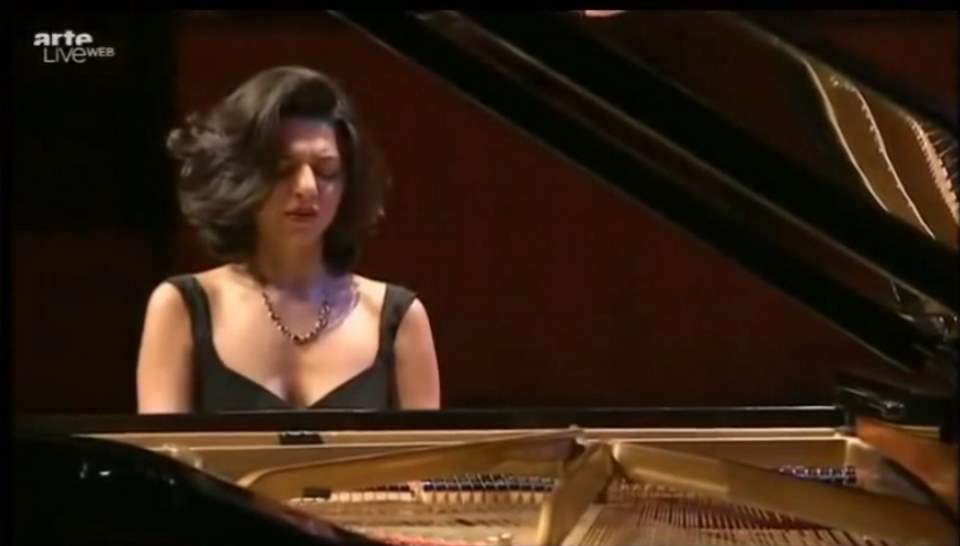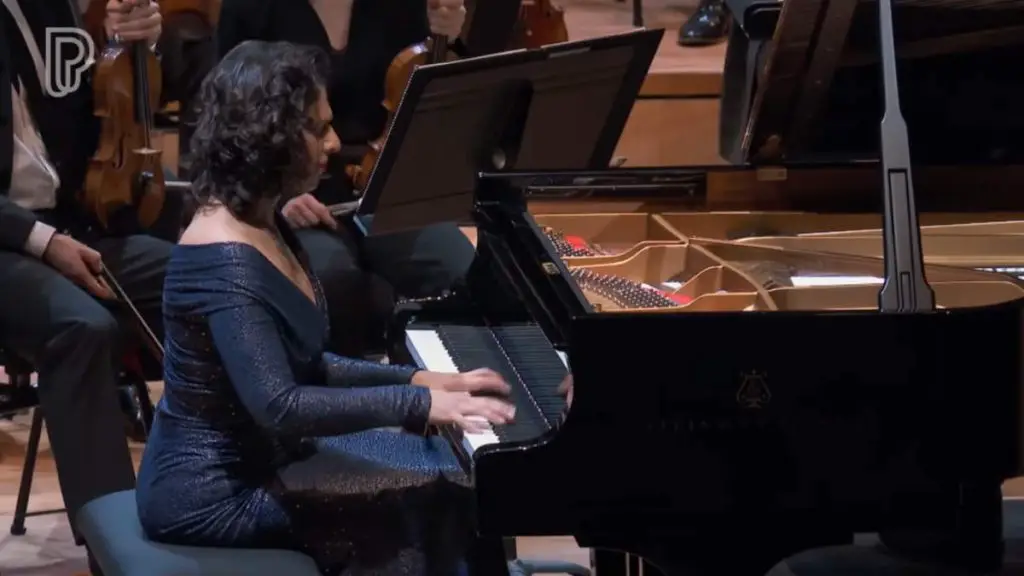Georgian classical pianist Khatia Buniatishvili plays Frédéric Chopin’s Ballade No. 4 in F minor Op. 52.
Frédéric Chopin’s Ballade No. 4
Chopin’s four ballades are one-movement pieces for solo piano, composed between 1831 and 1842. They are widely considered some of the most challenging pieces in the standard piano repertoire.
The term ballade was associated with an old French verse form used for grand and rhetorical subjects, but may also have connotations of the medieval heroic ballad, which was sung and danced. There are dramatic and dance-like elements in Chopin’s use of the genre, and he may be said to be a pioneer of the ballade as an abstract musical form. The four ballades are said to have been inspired by poet Adam Mickiewicz. The exact inspiration for each individual ballade, however, is unclear and disputed.
The ballades are considered an innovation of Chopin’s and cannot be placed into another form (e.g. sonata). Though they do not conform exactly to sonata form, the “ballade form” created by Chopin for his four ballades is a distinct variant of sonata form with specific discrepancies, such as the mirror reprise (presenting the two expositional themes in reverse order during the recapitulation). The ballades have directly influenced composers such as Franz Liszt and Johannes Brahms who, after Chopin, wrote ballades of their own.
Besides sharing the title, the four ballades are entities distinct from each other. According to the German composer and music critic Louis Ehlert (23 January 1825 – 4 January 1884), “Each (ballade) differs entirely from the others, and they have but one thing in common – their romantic working out and the nobility of their motifs.” Modern theorists have shown, however, that the ballades do have much in common, such as the “ballade meter” (6/4 or 6/8) and certain formal practices like the mirror reprise and delay structural dominance.
Ballade No. 4 in F minor, Op. 52 is considered by many pianists to be the most difficult of the four ballades, both technically and musically. According to John Ogdon, “(it is) the most exalted, intense and sublimely powerful of all Chopin’s compositions … It is unbelievable that it lasts only twelve minutes, for it contains the experience of a lifetime.”
It was composed in 1842 in Paris and Nohant and revised in 1843. The work was dedicated to Baroness Rothschild, wife of Nathaniel de Rothschild, who had invited Chopin to play in her Parisian residence, where she introduced him to the aristocracy and nobility. According to Robert Schumann, this Ballade was inspired by Adam Mickiewicz’s poem The Three Budrys, which tells of three brothers sent away by their father to seek treasures, and the story of their return with three Polish brides.
A phrase in the dominant key (marked piano) opens the seven introductory measures and leads into the first subject of sonata form exposition, a melody with Slavonic coloration. The first theme undergoes four cumulative transformations with decorations, counter-melodies, counterpoint, and a nocturne-like fioritura. The development of the second theme and its intertwining with the first heightens the complexity of the musical structure and builds tension.
Through the intertwining and thus the simultaneous development of the two themes, Chopin effectively combines the use of both the sonata form and the variation form. The body of the piece concludes with a series of accented fortissimo chords, followed by a momentary calm of five pianissimo chords. This then suddenly leads into an extremely fast, turbulent coda, written in exuberant counterpoint. Structurally Ballade No. 4 is decidedly intricate.
A distinguishing feature of the fourth Ballade is its contrapuntal nature. Counterpoint is found only sporadically in Ballades Nos. 1 and 2. The fourth Ballade is musically more subtle than the other three, as most of its portions remain melancholic and profound. Although there are some substantial outbursts in the central sections of the music, the coda reveals its greatest momentum.
Choin’s Ballade No. 4 has been used in television and cinema including The Bourne Supremacy (a 2004 American-German action and spy film) and The West Wing (an American serial political drama television series created by Aaron Sorkin that was originally broadcast on NBC from September 22, 1999, to May 14, 2006).
Sources
- Ballades (Chopin) on Wikipedia
- Verbier Festival on Wikipedia
- Pavarotti sings Pourquoi me réveiller [Massenet] at the Central Park in 1993 - April 23, 2024
- Elgar: Serenade for Strings [Concertgebouw Chamber Orchestra] - April 19, 2024
- Mozart: Serenade No. 10 “Gran Partita” [MET Orchestra Chamber Ensemble] - April 18, 2024



